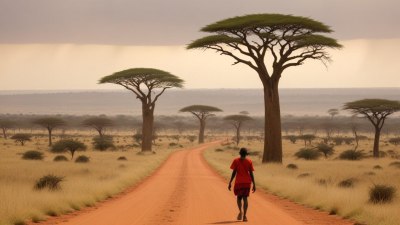Why Africa’s Climate Is Basically 'Choose Your Own Adventure'
Explore Africa's diverse climates and their unique impacts on ecosystems, agriculture, and human life.

This image was created with the assistance of Freepik
Africa's vast and varied landscapes create a mosaic of climates, leading to unique environmental challenges and opportunities.
Diversity of Climatic Zones
The continent is home to numerous climatic zones, from the arid deserts of the Sahara to the lush rainforests of the Congo Basin. This diversity results from a combination of geography, ocean currents, and prevailing winds, which influence rainfall patterns and temperature variation.
The Sahara Desert
The Sahara Desert, the largest hot desert in the world, dominates North Africa. It experiences extreme temperatures, scarce rainfall, and harsh living conditions, leading to a 'choose your own adventure' reality for inhabitants. People in this region face unique challenges, such as water scarcity and food security, but also exhibit remarkable resilience and adaptability.
The Sahel Region
Just south of the Sahara lies the Sahel, a semi-arid zone experiencing increased climatic variability. This region is marked by a mix of grasslands and scrub, providing a transition between the desert and the savanna. Here, communities engage in both agriculture and pastoralism, often facing the unpredictability of seasonal rains, which can lead to either drought or flooding.
West Africa's Tropical Climates
Moving further south, West Africa showcases tropical savannas and humid climates, primarily influenced by the Atlantic Ocean and the Intertropical Convergence Zone (ITCZ). This area is characterized by distinct wet and dry seasons, fostering a rich agricultural landscape where crops like millet, sorghum, and cassava thrive, albeit with the challenges posed by climate change.
The Central African Rainforest
At the heart of Africa, the Central African rainforest acts as a vital carbon sink, harboring incredible biodiversity. Here, temperatures remain consistent, and rainfall is ample throughout the year. However, anthropogenic pressures like deforestation and mining threaten this fragile ecosystem, leading to a critical 'choose your own adventure' for conservationists and local communities.
The Eastern Highlands
The eastern regions of Africa, including the Ethiopian Highlands and the Great Rift Valley, are characterized by elevation-driven climate variations. These highlands create unique microclimates supportive of diverse flora and fauna. Agricultural practices in this region are shaped by cooler temperatures and productive volcanic soils, offering rich farming opportunities.
Southern Africa's Varied Climate
Southern Africa displays a range of climatic conditions, from the arid conditions of the Kalahari Desert to the fertile lands of the Cape region. Each area requires distinct agricultural practices. The region is increasingly susceptible to climate extremes, necessitating adaptive strategies to mitigate impacts on food security.
Climate Change Impacts
Climate change poses significant risks across the continent, aggravating existing environmental issues. Rising temperatures, shifting rainfall patterns, and increased frequency of extreme weather events demand innovative approaches from policymakers, scientists, and communities. Adaptation strategies including drought-resistant crops, improved water management practices, and sustainable land use are essential for survival.
Case Studies: Adapting to Change
Several African nations are leading the way in climate adaptation initiatives. For instance, Ethiopia's “Productive Safety Net Program” aims to support rural households impacted by climate variability. In Kenya, sustainable agroforestry practices help restore deforested areas while improving food security and community resilience.
The Role of Technology
Technological advancements are playing an essential role in addressing Africa's climate challenges. Mobile technology enables farmers to receive timely weather information and market prices, while satellite imagery aids in resource management and tracking environmental changes. Furthermore, innovations in renewable energy help reduce dependency on fossil fuels, empowering communities with alternatives.
Global Cooperation and Local Action
Addressing climate issues in Africa necessitates a collaborative global effort. International partnerships focusing on sustainable development can provide valuable resources and knowledge transfer. However, grassroots movements and local action remain critical in building resilience and promoting sustainable practices tailored to unique contexts.
Youth Involvement
The youth of Africa are increasingly becoming the vanguard of climate action. From youth-led environmental organizations to innovative tech solutions, younger generations are taking the initiative to advocate for climate justice. Engaging them in decision-making processes is vital to ensure successful outcomes.
The Adventure Continues
Africa's climate narrative is indeed an adventure, filled with challenges and opportunities. Each region's unique climate features necessitate localized solutions, showcasing the innovative spirit of its people. Embracing the diversity and complexity of Africa's climates is essential in developing sustainable pathways for the future.











